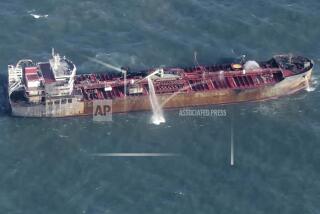Soviets Put Out Fire on Sub, Tow It Northeast : Weinberger Says Blast on Nuclear-Armed Craft Killed More Than 3; No Radiation Indicated
- Share via
WASHINGTON — Soviet sailors succeeded in extinguishing a fire inside their stricken nuclear submarine in the Atlantic on Sunday, and as darkness enveloped the vessel, it was being towed northeast by a Soviet merchant ship, the Pentagon said.
But Defense Secretary Caspar W. Weinberger told reporters aboard his plane en route from Anchorage, Alaska, to Tokyo that the violence of the explosion and fire aboard the vessel Friday and Saturday caused more than the three deaths so far reported by Tass, the official Soviet news agency.
Giving the first indication of what happened aboard the missile-launching vessel as it patrolled beneath the surface of the ocean, Weinberger told reporters that photographs from Navy surveillance planes keeping careful watch over the damaged submarine show that “the force of the explosion was very, very great” and indicate “a lot of damage.”
Some of the vessel’s hatches were blown away, part of the outer skin of its hull was peeled back and a hole was torn in its side, he said. “It looks a little bit like Chernobyl,” he added in a reference to the April 26 Soviet nuclear disaster in the Ukraine.
First reports from the area, about 480 nautical miles northeast of Bermuda, on Sunday morning said that smoke was still coming from inside the submarine’s hull and that crewmen could be seen on deck making efforts to put out the fire, more than 48 hours after it erupted.
No Radiation Increase
The exact source of the blaze has not been disclosed. Secretary of State George P. Shultz said that U.S. aircraft in the area had detected no increase in radiation in the environment.
A senior official of the British Defense Ministry was quoted by the Reuters news agency as speculating that the fire was caused by the explosion of the propellant in one of the 16 missiles aboard the submarine.
Pentagon spokesmen said they were unable to confirm the report, although it appeared consistent with Weinberger’s description of the damage. Each of the 16 missiles aboard the vessel, identified as a Yankee class submarine, is capable of launching two nuclear warheads on targets as far as 1,800 miles away. The subs routinely patrol both coasts of the United States, while more modern Soviet subs with longer-range missiles remain in Soviet waters.
Despite the heavy damage, the northeasterly heading taken when the submarine got under way Sunday afternoon indicated the crew intended to take the vessel home. After moving slowly under its own power for several hours, it was taken in tow by the Soviet merchant ship Krasnogvardevsk.
Although there is a Soviet navy base at Cienfuegos, on the southern coast of Cuba, about 1,200 miles to the southwest, the submarine with its nuclear weapons is forbidden to go there under the agreement between the United States and the Soviet Union that was reached after the 1962 Cuban missile crisis.
The submarine was accompanied by two other Soviet merchant vessels, which sources said had taken aboard an undetermined number of crew members from the submarine, and a single Soviet tug.
The U.S. Navy tug Powhatan was also said by the Pentagon to be in the vicinity.
Immediately after being informed of the accident Saturday, President Reagan offered any assistance to the submarine’s crew, but officials said there had been no response.
Earlier in the day Sunday, the vessel moved under its own power for a short time, then stopped for a few hours before it started up again at a speed of two knots.
The accident--at least the third major fire aboard a Soviet nuclear submarine in recent years--captured extraordinary attention because Soviet leader Mikhail S. Gorbachev informed President Reagan about it through diplomatic channels.
About 24 hours after the accident occurred, the Soviet Union publicly and privately gave its assurances that there was no danger of a nuclear explosion or of contamination of the environment.
Administration sources attributed the unusual Soviet candor to the approach of the Reagan-Gorbachev meeting in Iceland next weekend, continuing Soviet sensitivity to worldwide criticism after the Chernobyl nuclear disaster earlier this year and the certainty that an accident of such seriousness would become known in detail.
“Their usual pattern is to stonewall, to deny things have happened, on grounds that it’s embarrassing to the Soviet Union if something goes wrong,” Rep. Les Aspin (D-Wis.), chairman of the House Armed Services Committee, said on NBC’s “Meet the Press.”
He added: “I wouldn’t read an awful lot into it it except to note . . . it’s pretty hard for them to hide it, it’s so close to our shore.”
More to Read
Sign up for Essential California
The most important California stories and recommendations in your inbox every morning.
You may occasionally receive promotional content from the Los Angeles Times.













